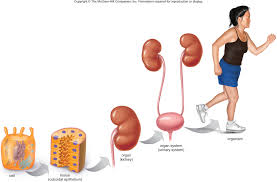Along this topic we have learn about the living things and the cells. Today we want to learn a bit more about the organization of cells. If we focus our attention in the cells we can classify the organisms into MULTICELLULAR and UNICELLULAR.
Let's have a look to this video and at the end of the video in the group you have to create a definition about what a multicellular and an unicellurar is.
UNICELLULAR ORGANISMS
Living things that are composed of a single cell are called unicellular organism. The single cell perform all the functions needed to live.
REMIND QUESTION: What are the vital functions of a living thing?
MULTICELLULAR ORGANISMS
Living things that are composed of two or more cells are called multicellular organism. All the cells are arranged so that the organism can performed the vital functions.
- LEVEL 1: It is the single cell.
- LEVEL 2: Tissues. They are a set of one type of cells which performs the same function.
- LEVEL 3: Organs. The grouping together of a set of tissues which performs the same function.
- LEVEL 4: System. Some organs that perform the same function are grouped together in a same system.
All the systems perform the ORGANISMS
Let's practise a bit more about Organization of Living Things using this video and the following test.
Types of cells
 Muscle cells are elongated. These cells and the tissues can expand and contract. This allows muscle to move.
Muscle cells are elongated. These cells and the tissues can expand and contract. This allows muscle to move.
Epithelial cells: These flat cells line certein area of the body such all the skin. They insulated the body and protect it.
Nerves cells: They are star shaped with long extension or arms. These cells establish connections and then transmit information to all parts of the body
To sum up and internalise your knowledge along this lesson you are going to create a model explaining from the cells to the organism. Let's use plasticine to create the model and paper to label it. Take a picture of it to publish it.
What do you have to do? Create a model using plasticine and paper to reproduce this photo.
STEP 1: Decide with your mates what you are going to represent. Let's investigate how it is and how to represent.
STEP 2: Talk with your mates about the material you will need and how do you will organize to have it (plasticine, sticks, papers, and if it is posible a camera to take a photo)
STEP 3: Organize the group deciding who is going to do each things, who is going to create the cell, who the tissue, the organ,.....
STEP 4: Work on your part of the task, don't hesitate to ask for help to your mates in case it is necesary.
STEP 5: Let's prepare the final model and take a picture and send it to your teacher.
STEP 6: Each group will show the final product to the rest of the groups.







No hay comentarios:
Publicar un comentario